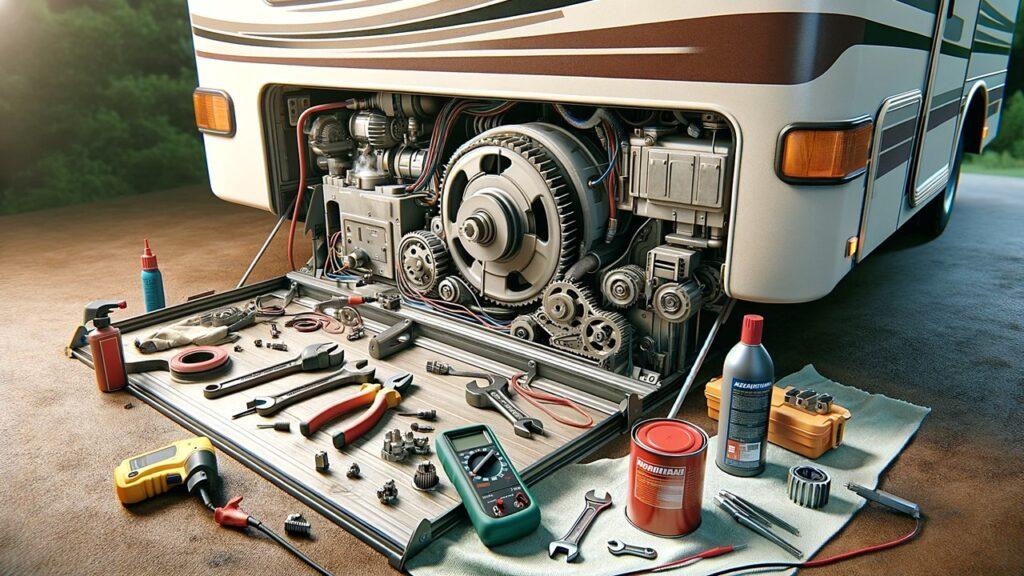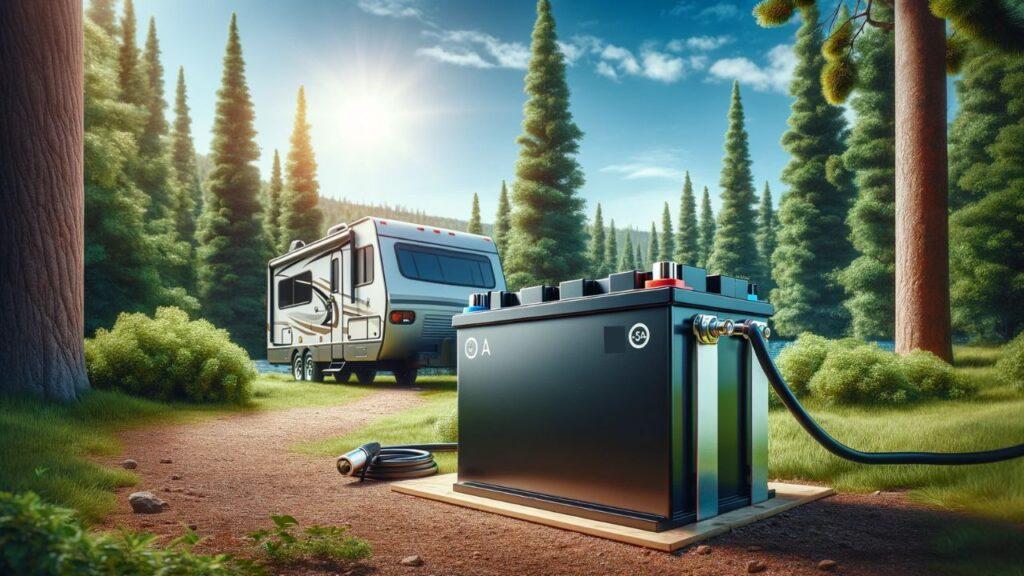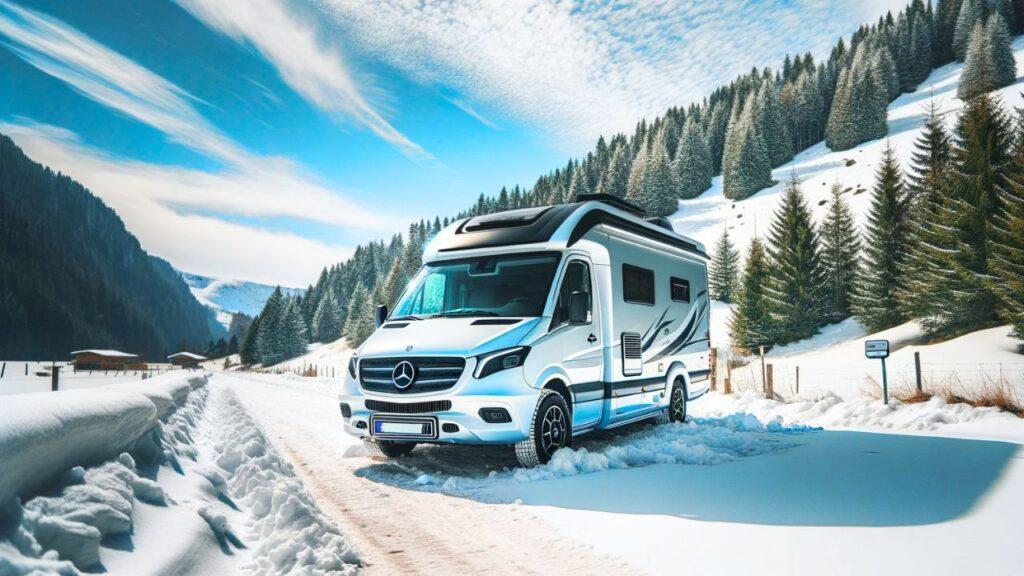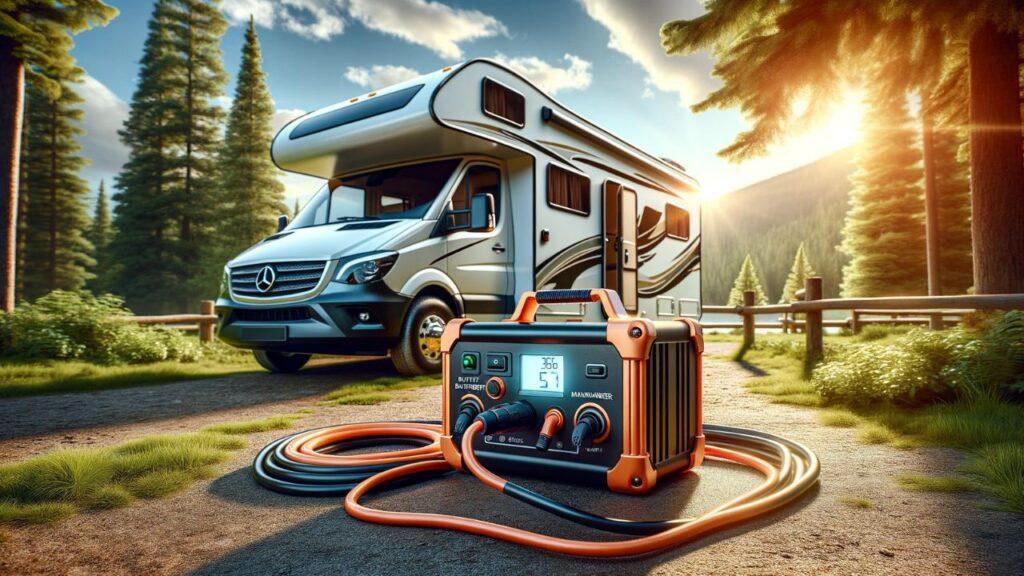An electric space heater turns your RV into a warm, cozy retreat, no matter how cold it gets outside. Compact and efficient, it’s the perfect way to stay comfortable on chilly nights without cranking up. In this guide, we have extensively researched, reviewed, and ranked the 9 best RV electric space heaters for your camper van living in 2025.
We’re reader-supported. When you buy through links on our site, we may earn an affiliate commission. As an Amazon Associate, we earn from qualifying purchases.
Our Top 9 Picks Of The Best RV Electric Space Heaters For Van Life
- Overall Option: Dr Infrared Heater Portable Space Heater
- Budget Friendly Option: Dreo Space Heater Portable Electric
- Dual Feature Option: Lasko Oscillating All Season Tower Fan and Space Heater
- Value for Money Option: Amazon Basics Portable Space Heater
- Ceramic Option: Dreo Space Heater 1500W PTC Ceramic
- Energy Efficient Option: Vornado MVH Space Heater
- Infrared Heating Option: Heat Storm Phoenix HS-1500-PHX
- Compact Portable Option: Honeywell HHF370B
- Quiet Operation Option: DR. INFRARED HEATER DR-978
What Is The Best RV Electric Space Heater In 2025?
Selecting the perfect RV electric space heater can be a game-changer for your travels. From energy efficiency to compact design, we’ve got you covered, ensuring your road trips are as cozy as they are memorable. Here are our top picks:
1. Overall Option: Dr Infrared Heater Portable Space Heater
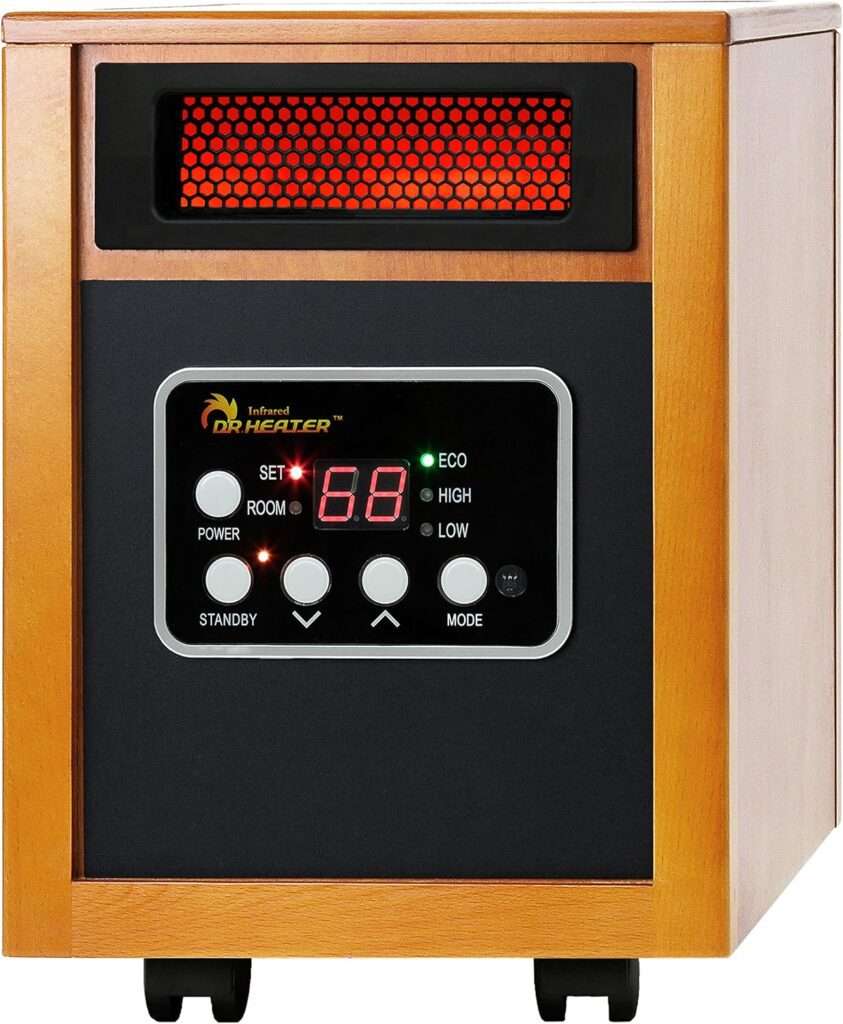
Key Specifications
- Brand: Dr. Infrared Heater
- Weight: 19 lbs
- Dimensions: 13″D x 12.5″W x 17″H
- Power Output: 1500 watts
- Heating Method: Infrared quartz tube + PTC
- Heat Output: 5200 BTU
- Coverage Area: Up to 576 sq. ft.
- Safety and Features: Tip-over protection, overheat protection, remote control, thermostat (50-85°F), 12-hour timer, caster wheels
For RV and camper van owners looking for a reliable and efficient electric space heater, the Dr Infrared Heater Portable Space Heater is a proper option. It combines infrared quartz and PTC heating to spread warmth evenly, eliminating cold spots while keeping energy use in check. With 5200 BTU of heat output, it quickly warms up even larger RV interiors, making it a great fit for winter camping. The built-in thermostat and remote control let you set the perfect temperature without having to get up, which is a big plus when trying to stay cozy in a small space.
From our standpoint, portability and safety make this heater stand out for RV living. The caster wheels make it easy to move around, and the quiet blower keeps noise to a minimum—no loud humming while trying to sleep. Safety is also well-covered with tip-over and overheat protection, which is important when using a heater in a compact space like a camper van. It runs smoothly on standard RV power outlets, and the auto mode helps maintain a comfortable temperature without unnecessary energy waste. Considering its performance, ease of use, and safety, it’s a proper overall option for keeping an RV or camper van warm.
Pros
- High heat output warms RV interiors quickly
- Remote control and thermostat for easy adjustments
- Quiet operation with low-noise blower
- Safety features prevent overheating and tip-over risks
Cons
- Needs a power outlet, not battery-operated
- Freestanding design, not mountable
2. Budget Friendly Option: Dreo Space Heater Portable Electric

Key Specifications
- Brand: Dreo
- Weight: 3 lbs
- Dimensions: 7.32″D x 7.32″W x 11.02″H
- Power Output: 1500 watts
- Heating Method: PTC Ceramic
- Heat Output: 1500 watts
- Coverage Area: Up to 200 sq. ft.
- Safety and Features: Tip-over protection, overheat protection, child lock, remote control, thermostat (41-95°F), 12-hour timer
The Dreo Space Heater Portable Electric is an excellent choice for RVers and camper van travelers looking for a compact yet powerful heating solution. It delivers quick and steady warmth using PTC ceramic heating, making it ideal for smaller RV spaces. The adjustable thermostat and multiple modes allow precise temperature control, ensuring the right balance between comfort and energy efficiency. Its remote control and digital display make it effortless to use, while the 34 dB quiet operation ensures peaceful nights on the road.
From our standpoint, portability and safety make this heater a proper fit for RV life. We appreciate the lightweight design and built-in handle, which make it easy to move around. The flame-resistant build, tip-over sensor, and overheat protection add peace of mind, especially in compact spaces. The eco mode helps save energy, making it a smart choice for those mindful of power consumption. Considering its performance, convenience, and safety, it’s a great budget-friendly option for camper van and RV heating needs.
Pros
- Fast and efficient heating
- Lightweight and easy to move
- Multiple heat modes for flexibility
- Quiet operation at 34 dB
Cons
- Needs to be plugged in at all times
- Not ideal for heating large RVs
3. Dual Feature Option: Lasko Oscillating All Season Tower Fan and Space Heater
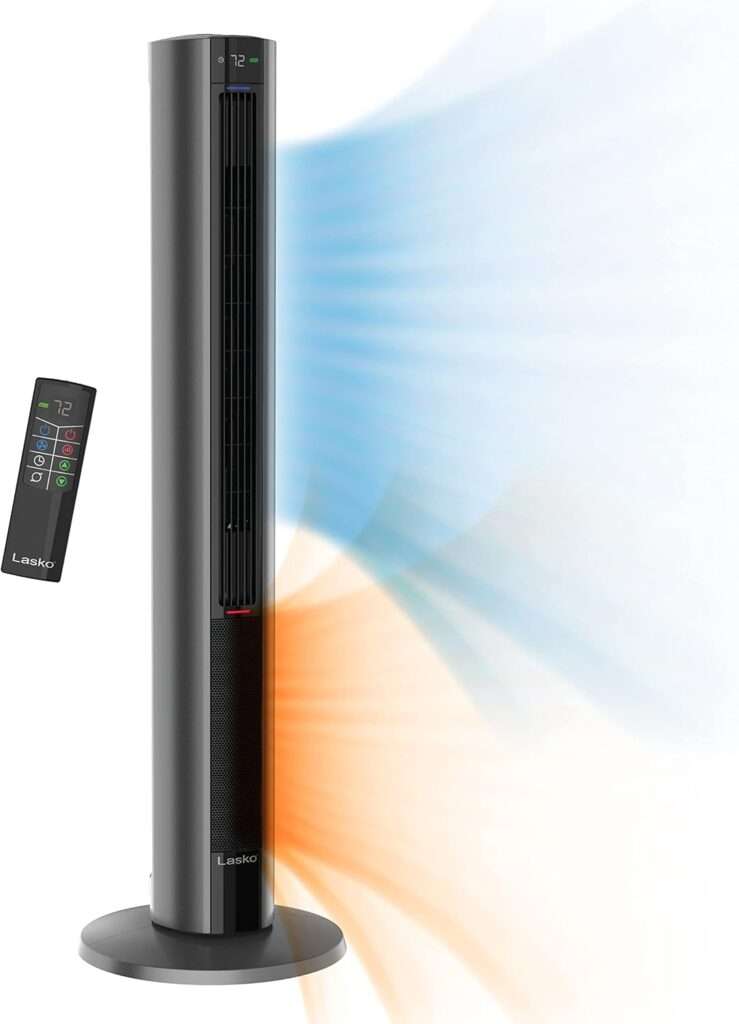
Key Specifications
- Brand: Lasko
- Weight: 11.5 lbs
- Dimensions: 12.5″D x 12.5″W x 41.89″H
- Power Output: 1500 watts
- Heating Method: Ceramic
- Heat Output: 5100 BTU
- Coverage Area: 150 sq. ft.
- Safety and Features: Tip-over protection, overheat protection, remote control, thermostat, 8-hour timer, oscillation
For those who need year-round comfort in their RV or camper van, the Lasko Oscillating All Season Tower Fan and Space Heater is a proper pick. It functions as both a fan and a heater, making it a great fit for changing weather on the road. The ceramic heating system delivers 5100 BTU of warmth, ensuring a cozy space on chilly nights. When the weather shifts, the four fan speeds provide steady airflow, helping to keep things fresh inside. The slim tower design saves space, and the oscillation feature spreads heat or cool air evenly.
From our perspective, ease of use and safety make this a solid option for RV living. The remote control and thermostat settings allow quick adjustments, while the tip-over switch and overheat protection add peace of mind. It’s also light enough to move around, which is useful in small camper spaces. The 8-hour timer helps conserve energy, and the cool-touch exterior prevents accidental burns. With its dual functionality, portability, and practical features, it’s a well-rounded option for keeping an RV comfortable in any season.
Pros
- Dual fan and heater functions
- Oscillating airflow for even heat
- Remote control for easy adjustments
- Space-saving tower design
Cons
- Requires a constant power source
- Not designed for large RVs
4. Value for Money Option: Amazon Basics Portable Space Heater
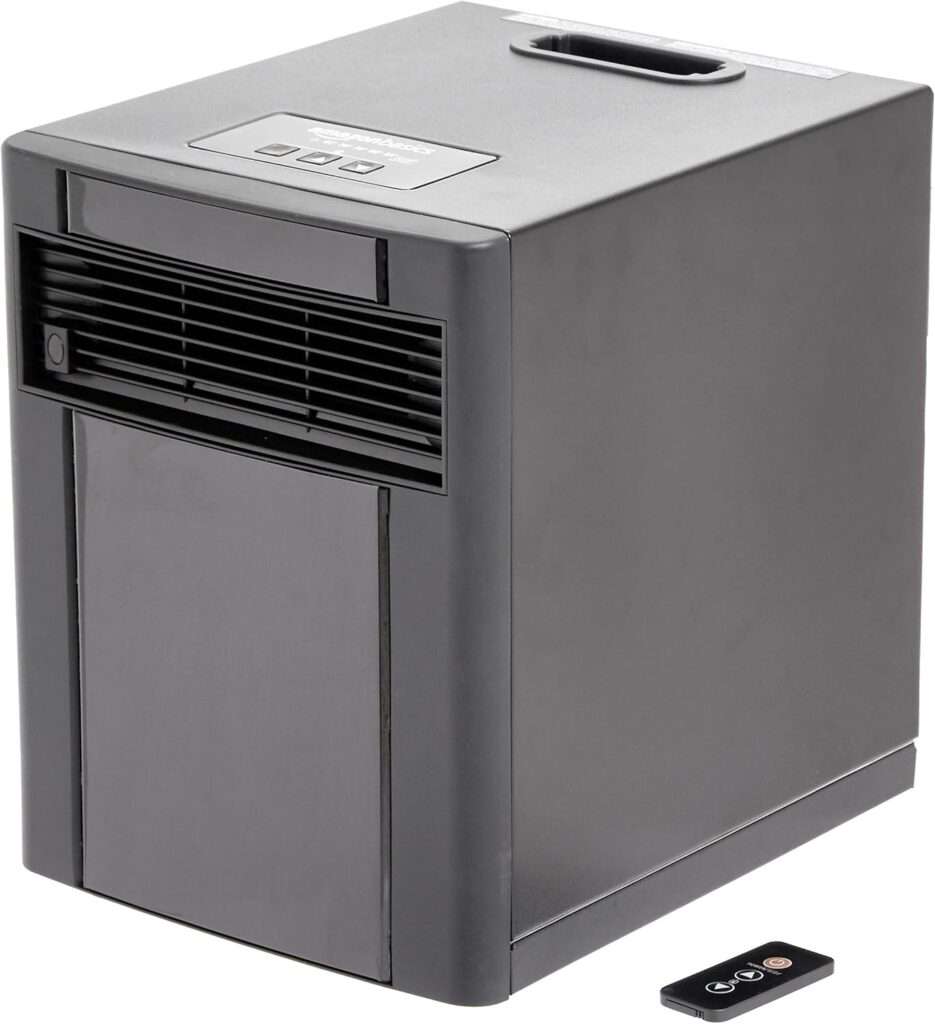
Key Specifications
- Brand: Amazon Basics
- Weight: 14.52 lbs
- Dimensions: 11.4″D x 14.5″W x 14.7″H
- Power Output: 1500 watts
- Heating Method: Infrared heating
- Heat Output: 1500 watts
- Coverage Area: Up to 160 sq. ft.
- Safety and Features: Adjustable thermostat, overheat sensor, remote control, LED display, ECO-Smart setting
For RVers looking for a solid, no-fuss heating solution, the Amazon Basics Portable Space Heater is a proper pick. It uses infrared heating, which means it warms up the space efficiently without drying out the air. The adjustable thermostat lets you set the temperature between 65-85°F, making it easy to customize comfort levels. Plus, the ECO-Smart setting helps conserve energy, which is especially useful when running off limited RV power. The LED display and remote control make it simple to adjust settings without getting up.
From our perspective, portability and safety make this heater an excellent choice for camper vans and RVs. The compact cabinet design allows it to fit in tight spaces without taking up too much room. It’s sturdy enough to handle travel but light enough to move around when needed. The overheat sensor adds peace of mind, and with two heat settings, it adapts well to different weather conditions. Considering its efficiency, features, and ease of use, it’s a great value-for-money option for RV heating.
Pros
- Strong and consistent heating
- Easy-to-use remote and LED display
- Compact and travel-friendly design
- Energy-saving ECO mode
Cons
- Needs a direct power source
- Not ideal for very large RVs
5. Ceramic Option: Dreo Space Heater 1500W PTC Ceramic

Key Specifications
- Brand: Dreo
- Weight: 4.63 lbs
- Dimensions: 5.9″D x 5.89″W x 15.79″H
- Power Output: 1500 watts
- Heating Method: PTC Ceramic
- Heat Output: 1500 watts
- Coverage Area: Up to 200 sq. ft.
- Safety and Features: Tip-over protection, overheat protection, remote control, LED display, adjustable thermostat (41-95°F), 70° oscillation, ECO mode
The Dreo Space Heater 1500W PTC Ceramic is an excellent choice for RV and camper van owners looking for a compact and efficient heater. It delivers fast warmth with its PTC ceramic heating, ensuring even heat distribution without making the air dry. The 70° oscillation spreads warmth across the space, making it ideal for small and mid-sized RV interiors. With five heat settings and an ECO mode, it maintains a comfortable temperature while managing energy use efficiently. The LED display and remote control make adjustments simple, even when lying in bed.
From our standpoint, portability and safety make this heater a proper fit for RV camping. The lightweight design and hidden handle allow easy movement, while the compact frame saves space in a camper van. Safety is well covered with tip-over and overheat protection, plus a built-in timer for added control. The quiet operation at 40 dB ensures peaceful nights, which is a big plus when sleeping in a small space. Considering its efficiency, ease of use, and safety features, it’s a solid ceramic option for staying warm on the road.
Pros
- Fast and even heating
- Compact and lightweight design
- Energy-efficient ECO mode
- Quiet operation at 40 dB
Cons
- Requires a constant power source
- Not ideal for heating large RVs
6. Energy Efficient Option: Vornado MVH Space Heater
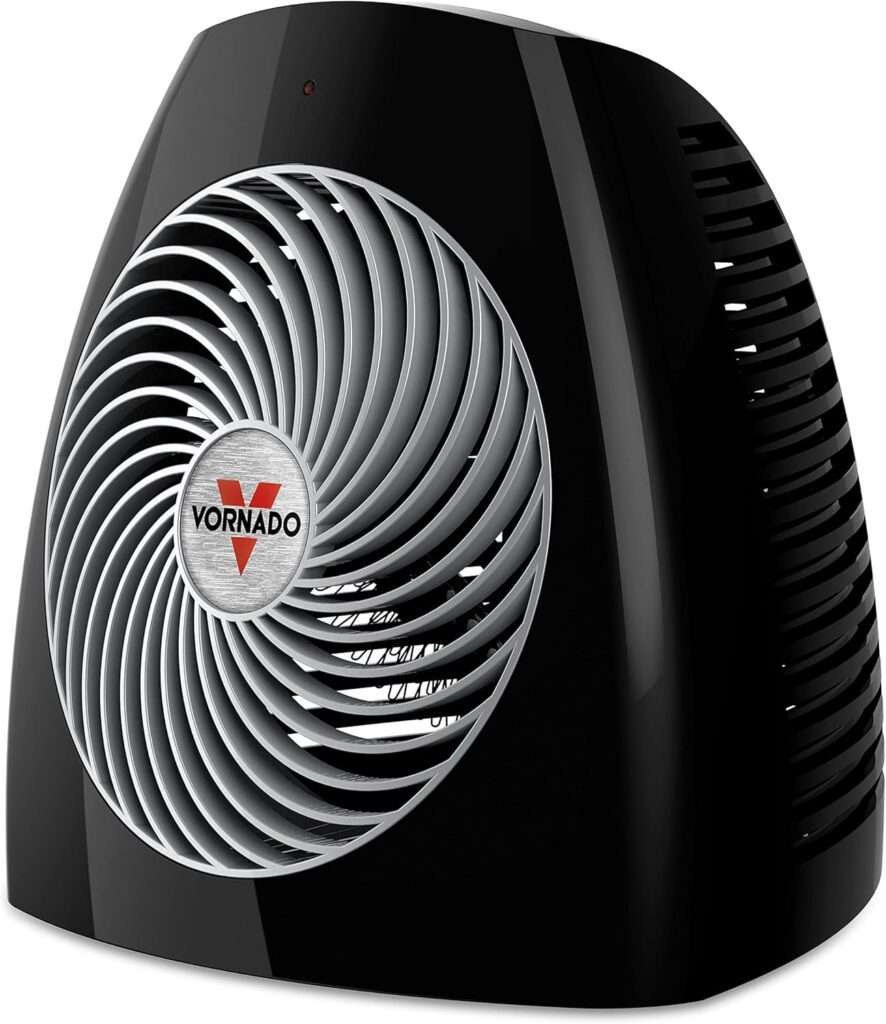
Key Specifications
- Brand: Vornado
- Weight: 3.76 lbs
- Dimensions: 9.2″D x 10.4″W x 10.6″H
- Power Output: 120 volts
- Heating Method: Forced air
- Heat Output: 120°F
- Coverage Area: Up to 256 sq. ft.
- Safety and Features: Tip-over protection, overheat protection, adjustable thermostat, cool-touch exterior, three heat settings
In our experience, the Vornado MVH Space Heater brings effortless warmth to your RV setup. This heater’s vortex air circulation cleverly distributes heat throughout the space, creating a cozy atmosphere without those annoying hot and cold zones. With its compact design, it fits snugly into tight corners, making it a natural companion for life on the road. Adjusting between the three heat settings is a breeze, allowing you to tweak the temperature to your comfort level without any hassle.
What really catches our attention is how safe and traveler-friendly this heater is. Its cool-touch exterior means no burnt fingers while moving it around, and the tip-over protection ensures it’s a safe pick for cramped camper vans. The quiet operation is a plus point too, as it lets you enjoy the warmth without the buzz. If you’re after a reliable, energy-conscious option that blends into RV life seamlessly, this heater seems to check all the right boxes.
Pros
- Balanced and steady heat
- Lightweight and easy to carry
- Quiet enough for a peaceful night
- Simple temperature control
Cons
- Needs a nearby outlet
- Limited to smaller spaces
7. Infrared Heating Option: Heat Storm Phoenix HS-1500-PHX
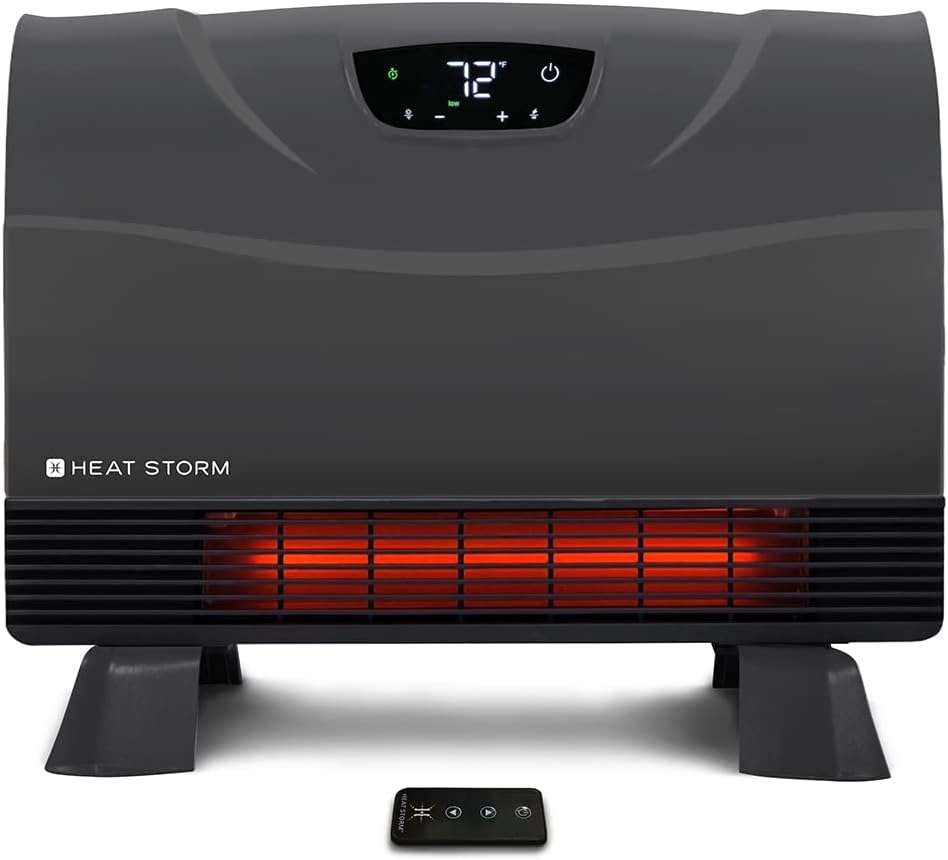
Key Specifications
- Brand: Heat Storm
- Weight: 8 lbs
- Dimensions: 18.75″D x 4.5″W x 12.75″H
- Power Output: 1500 watts
- Heating Method: Infrared Quartz
- Heat Output: 5200 BTU
- Coverage Area: 150 sq. ft. primary, 750 sq. ft. secondary
- Safety and Features: Overheat protection, remote control, digital display, adjustable thermostat, wall and floor mounting options
For RV owners who want efficient and flexible heating, the Heat Storm Phoenix HS-1500-PHX stands out as a proper choice. It offers powerful infrared heating that warms up the space without drying out the air, making it a comfortable option for extended stays. With dual power modes, it adapts well to changing temperatures, running at 750 watts for mild cold or 1500 watts for freezing nights. The built-in thermostat and LED display make it easy to control, while the included remote allows adjustments from anywhere inside the RV.
From our perspective, what makes this heater ideal for camper van life is its space-saving design and safety features. The wall-mount option is a great way to free up floor space, but it also comes with attachable feet for those who prefer to move it around. The cool-to-touch grill and overheat protection add extra peace of mind when using it in tight quarters. Plus, it’s lightweight and portable, so taking it along on road trips is hassle-free. With its reliable heat output, flexible placement options, and energy efficiency, it’s a great infrared heating option for RV travelers.
Pros
- Powerful infrared heating
- Wall or floor mount flexibility
- Remote control for convenience
- Energy-efficient dual modes
Cons
- Needs a power source nearby
- Not ideal for heating large RVs
8. Compact Portable Option: Honeywell HHF370B

Key Specifications
- Brand: Honeywell
- Weight: 3 lbs
- Dimensions: 8″D x 8″W x 11.5″H
- Power Output: 1800 watts
- Heating Method: Radiant & Infrared, Fan & Forced Air
- Heat Output: 360° surround heat
- Coverage Area: Small to mid-sized spaces
- Safety and Features: Tip-over protection, overheat protection, adjustable thermostat, cool-touch handle, two heat settings
If you need a compact and reliable heater for your RV, the Honeywell HHF370B is a proper pick. It delivers warmth in all directions, thanks to its 360° surround heat output, ensuring no cold corners in your camper van. The adjustable thermostat makes it easy to control the temperature, while the dual heat settings let you adjust the warmth based on your needs. It’s small but effective, making it a great fit for tight spaces inside an RV without taking up much room.
From our standpoint, portability and safety make this heater a solid choice for RVers. The cool-touch handle allows easy movement, and the sturdy base keeps it stable, even on uneven camper floors. With tip-over and overheat protection, it adds an extra layer of safety, which is always a priority in smaller living spaces. Plus, its energy-efficient design helps keep power usage in check, making it practical for extended road trips. Considering its compact size, reliable heat output, and safety features, this is a great portable heating option for any RV setup.
Pros
- 360° all-around heat
- Compact and lightweight design
- Easy to adjust settings
- Built-in safety features
Cons
- Needs a power outlet nearby
- Not ideal for large RVs
9. Quiet Operation Option: DR. INFRARED HEATER DR-978
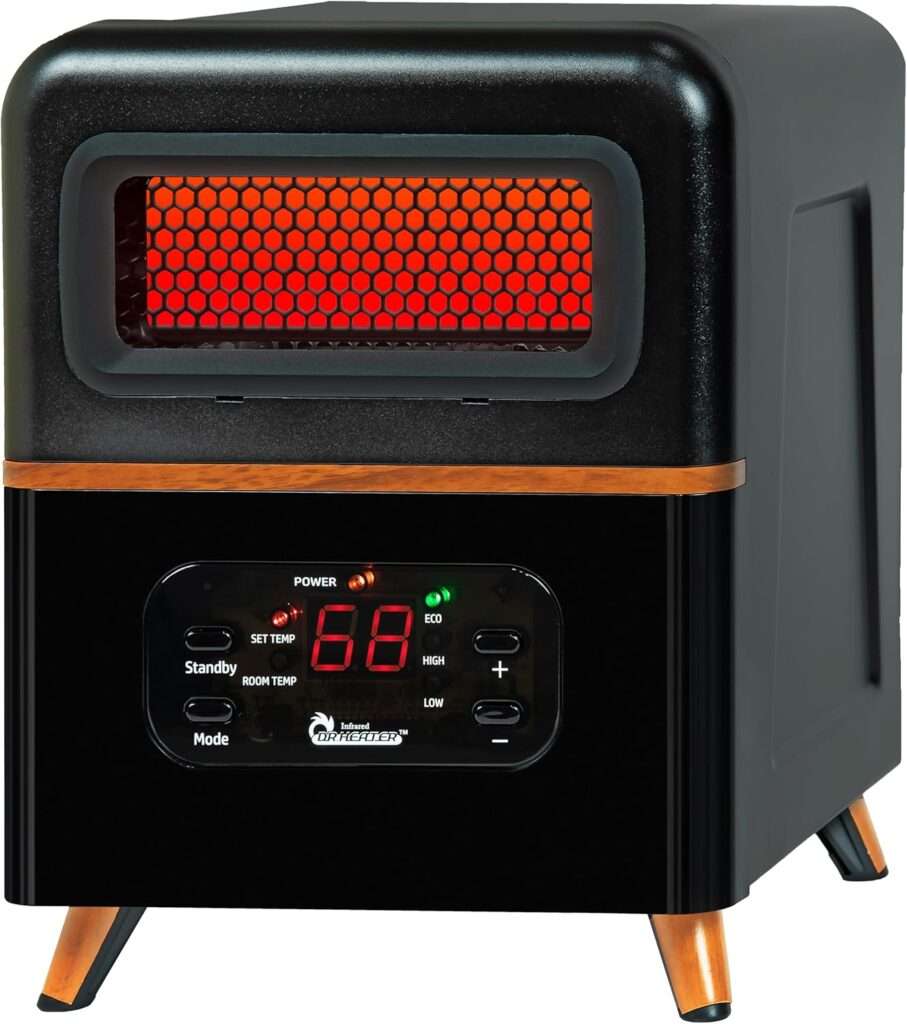
Key Specifications
- Brand: DR. INFRARED HEATER
- Weight: 10 lbs
- Dimensions: 10″D x 9″W x 12″H
- Power Output: 1500 watts
- Heating Method: Hybrid Dual Heating (PTC + Infrared)
- Heat Output: 5200 BTU
- Coverage Area: Up to 400 sq. ft.
- Safety and Features: Tip-over protection, overheat protection, adjustable thermostat (50-85°F), remote control, ECO mode, 12-hour timer
If keeping an RV warm without loud fan noise is a priority, the DR. INFRARED HEATER DR-978 is a proper pick. It combines PTC and infrared heating, ensuring fast and even warmth while maintaining a quiet operation. The high-velocity blower pushes out warm air efficiently, covering up to 400 sq. ft. without making a disruptive sound. The adjustable thermostat helps maintain a steady temperature, while the ECO mode keeps power usage in check, which is great for RVs running on limited electricity.
From our standpoint, this heater’s portability and safety features make it an excellent choice for camper van owners. The compact cabinet design fits easily in small spaces, and the remote control allows quick adjustments without leaving your seat. More importantly, the tip-over and overheat protection provide extra safety, especially when moving around in an RV. The sturdy build and durable components ensure it lasts through multiple camping seasons. Considering its quiet function, efficient heating, and smart safety features, this heater is a solid option for RV travelers who need warmth without the noise.
Pros
- Powerful yet quiet blower
- Dual heating system for efficient warmth
- Compact and easy to move
- Remote-controlled settings
Cons
- Needs a direct power source
- Not for extra-large RVs
Waht Are Electric Space Heaters For RV?
Embarking on an RV journey brings the joy of exploration and the challenge of maintaining comfort. Among the essentials for any RV, electric space heaters play a crucial role. They provide warmth and comfort during chilly nights and brisk mornings, making your mobile home cozy and inviting. Understanding the different types of electric heaters, how they function, and their safety features is essential for any RV owner or enthusiast.
Types of Electric Heaters
- Convection Heaters: These heaters warm the air in a room, creating a cycle of rising and falling warm air. Ideal for consistent, whole-room heating, they’re a popular choice in the RV community.
- Radiant Heaters: Radiating heat directly to objects and people, these heaters provide quick, targeted warmth. They’re perfect for heating up small spaces quickly.
- Ceramic Heaters: Using ceramic plates and aluminum baffles, these heaters are efficient and safe. They’re excellent for heating small to medium-sized RV spaces.
- Oil-Filled Heaters: Known for their long-lasting heat, these heaters use heated oil to warm the air. They are great for sustained heating and are energy-efficient.
How Electric Heaters Work
- Heating Elements: The core of any electric heater, these elements convert electrical energy into heat.
- Thermostats and Controls: These allow users to set and maintain desired temperatures, ensuring comfort and energy efficiency.
- Energy Efficiency: Modern electric heaters are designed to provide maximum warmth while using minimal energy, a crucial feature for RV living where energy sources might be limited.
Safety Features
- Automatic Shut-Off: This feature turns the heater off in case of overheating, preventing potential fire hazards.
- Tip-Over Protection: Especially important in a moving RV, this feature shuts the heater off if it’s knocked over.
- Overheat Protection: An internal sensor triggers this safety mechanism if the heater reaches an unsafe temperature.
Selecting the right electric space heater for your RV involves considering various types. Understanding their functionality, and ensuring they have essential safety features and power from generators or other off-grid power source. Whether you prefer the even warmth of a convection heater or the targeted heat of a radiant heater, each type has its unique benefits. Moreover, features like energy efficiency and safety mechanisms are non-negotiable for a safe and enjoyable RV experience. With this knowledge, you’re well-equipped to choose the best electric space heater for your RV adventures.
How To Choose The Right Electric Space Heater For Your RV?
When venturing into the vast world of RV travel, the comfort of your rolling home is paramount. A key component of this comfort during colder months is the right RV electric space heaters. The perfect heater not only warms your space but does so efficiently and safely, enhancing your RV experience. As the choice of heater can significantly impact your travel lifestyle, understanding the factors that go into selecting the right one is crucial. This expanded guide dives deeper into the aspects of size, energy efficiency, and functional features, ensuring your heater is a tailored fit for your RV’s unique needs.
Size and Capacity Considerations
- Matching Heater Size with RV Size: It’s vital to balance the heater’s size with your RV’s interior dimensions. A small heater might struggle in a large RV, while a too-powerful heater can overwhelm a compact space.
- Wattage and BTU Ratings: These are critical figures. A higher wattage or BTU rating typically means more heat output, but also greater power consumption. Choosing the right balance is key for effective heating without draining your RV’s resources.
Energy Efficiency
- Understanding Energy Consumption: Grasping the energy consumption of your heater is essential, especially since RVs often have limited power supply options. A more energy-efficient heater means longer lasting warmth without the worry of depleting your resources.
- Cost-Effective Heating Solutions: Look for heaters that strike a balance between power consumption and heat output. Features like programmable thermostats or eco-modes can contribute to reducing overall energy usage, making your heating choice both efficient and economical.
Features and Functionality
- Adjustable Thermostats: A heater with an adjustable thermostat offers the flexibility to set a comfortable temperature, crucial for adapting to varying weather conditions and personal preferences.
- Remote Control Operations: The convenience of a remote control cannot be overstated, especially in the compact space of an RV. Adjusting settings from your bed or dining area adds a layer of comfort and convenience.
- Timer Functions: A heater with a timer function adds to the safety and energy efficiency of your RV. Setting specific heating times can prevent overheating and excessive power use, especially helpful when you’re asleep or away from your RV.
Selecting the right RV electric space heaters is a multifaceted decision that extends beyond just heating your space. It’s about finding a heater that harmonizes with your RV’s size, optimizes energy consumption, and offers user-friendly features. This thoughtful approach ensures your chosen heater not only provides warmth but also contributes to a safe, efficient, and enjoyable RV living experience. With this comprehensive guide, you’re now equipped to make an informed decision, ensuring your travels are as warm and comfortable as they are adventurous.
Electric Space Heater Installation And Setup In RV Camper
Introducing RV electric space heaters into your RV Camper Van not only elevates comfort but also turns it into a warm sanctuary against the cold. This installation, though seemingly simple, demands attention to detail for optimal safety and efficiency. Our comprehensive guide meticulously breaks down the process, offering clarity from start to finish. We focus on the nuances of heater installation, from selecting the right tools to positioning the heater strategically within your RV. These instructions are tailored to ensure your electric space heater becomes a seamless, efficient addition to your camper van.
Installation Basics
- Step-by-Step Installation Guide: Starting with unboxing your new heater, we guide you through each step. We’ll cover how to securely mount it, if necessary, and connect it safely to your RV’s power source.
- Necessary Tools and Equipment: A successful installation hinges on having the right tools. We’ll list the essentials, including screwdrivers, mounting hardware, and electrical testers, ensuring you’re well-prepared for the task.
Optimal Placement for Efficiency
- Heat Distribution: Placement is key for maximum efficiency. We delve into how to position your heater to evenly distribute heat throughout your RV, considering factors like layout and airflow.
- Ventilation and Clearance: We emphasize the importance of maintaining adequate clearance around your heater. Proper ventilation is critical to prevent overheating and to ensure safe operation.
Installing an electric space heater in your RV Camper Van is a straightforward yet crucial task. Each step, from selecting the right heater to its final setup, impacts the overall comfort and safety of your RV. Furthermore, understanding the technicalities of installation and the principles of optimal heater placement can significantly enhance your RV’s warmth and energy efficiency. With this detailed guide, you’re now equipped to ensure your RV remains a cozy retreat, no matter where your travels take you.
Safety and Maintenance for RV Electric Space Heaters
In the cozy confines of an RV, an electric space heater is more than a luxury—it’s a necessity for comfort and warmth. However, its effectiveness and safety hinge on how well it’s maintained and the precautions taken during its use. This guide delves deeper into the critical aspects of safety guidelines and meticulous maintenance for RV electric space heaters. By rigorously following these practices, you ensure not just warmth in your mobile abode but also peace of mind, knowing your heater is functioning safely and efficiently.
Safety Guidelines
- Safe Operation Practices: We emphasize the importance of thoroughly understanding your heater’s operational guidelines. This includes familiarizing yourself with its features, proper placement away from foot traffic, and never covering the heater while it’s running.
- Preventing Fire Hazards: Detailed guidance is provided on preventing fire risks. Key measures include using a dedicated power outlet to avoid overloading, not using extension cords, and ensuring the heater is placed on a stable, non-flammable surface. Regularly checking the heater for any signs of malfunction, such as unusual smells or sounds, is also crucial.
Maintenance and Care
- Regular Cleaning: Dust and debris can significantly hinder a heater’s performance. We outline a safe cleaning regimen, detailing how to unplug the unit, clean its exterior and interior (if accessible), and check for any blockages in the ventilation system.
- Inspecting for Damages: A thorough inspection routine is outlined, focusing on the heater’s cord, plug, and heating elements. Any signs of wear, tear, or damage call for immediate attention to prevent potential hazards.
- Long-Term Storage Tips: Guidance on proper storage includes cooling the heater before packing, cleaning it thoroughly, and storing it in a dry, dust-free environment. We also advise on checking the heater before reuse, especially after prolonged storage.
While an electric space heater in your RV ensures warmth and comfort, its safety and efficiency are contingent upon proper usage and regular maintenance. Adhering to these expanded safety guidelines and undertaking diligent care routines will not only extend the life of your heater but also safeguard your RV environment. Moreover, these practices ensure that your adventures remain warm and worry-free, with your heater operating as a reliable source of warmth in your travels. Remember, a well-maintained heater is integral to a safe and comfortable RV experience.
Common Challenges and Solutions While Using Electric Space Heater for RV
RV living combines adventure with the comforts of home, and a key component of that comfort is a reliable heating system. Electric space heaters are a popular choice among RV enthusiasts, offering efficient and convenient heating solutions. However, as with any appliance, they may occasionally encounter issues. This detailed guide aims to address common challenges associated with RV electric space heaters, offering practical troubleshooting tips and insights into when to tackle repairs yourself or seek professional help. Our goal is to empower RV owners with the knowledge to maintain a comfortable and warm environment, ensuring their journey is as smooth as the roads they travel.
Troubleshooting Common Issues
- Heater Not Turning On: Here, we’ll delve deeper into common reasons your heater might not power up, such as tripped circuit breakers, faulty power outlets, or internal thermostat issues, providing step-by-step solutions for each scenario.
- Inadequate Heating: If your heater isn’t performing as expected, we explore potential causes, including blocked air filters, incorrect size for your RV, or external temperature factors, along with effective methods to resolve these issues.
- Strange Noises or Smells: We address the causes of unusual noises and odors, from dust accumulation to mechanical failures, offering guidance on how to identify and rectify these concerns to ensure your heater’s safe and efficient operation.
Professional Repairs vs. DIY Fixes
- When to Call a Professional: Identifying when a problem requires professional expertise is critical for safety and the longevity of your heater. We highlight signs indicating the need for professional intervention, such as electrical faults, persistent issues after basic troubleshooting, or when warranty terms are involved.
- Simple DIY Repairs and Maintenance: For less complex issues, our guide offers easy-to-follow DIY solutions, including regular cleaning, basic component checks, and simple repairs, enabling you to maintain your heater’s optimal performance without professional assistance.
Addressing the challenges associated with RV electric space heaters is key to a comfortable and worry-free RV experience. Understanding how to effectively troubleshoot common issues and discern when professional help is needed not only ensures your heater’s reliability but also contributes to your overall safety on the road. Equipped with these comprehensive insights, you can confidently manage your RV’s heating needs, ensuring a cozy and enjoyable environment in your mobile home, no matter your destination.
Enhancing Your RV Camper Heating Experience With Electric Space Heater
Embarking on an RV adventure means being prepared for all kinds of weather. While a top-notch RV space electric heater is key, there’s more to creating a warm and comfortable environment. This guide expands on ways to elevate your RV’s heating system, focusing on complementary methods and smart technologies. By integrating these solutions, you can transform your RV into a cozy retreat, ensuring warmth and comfort follow you on your journeys.
Complementary Heating Solutions
- Layering with Insulation: Effective insulation is paramount for retaining heat. We explore various insulation materials suitable for RVs, their installation methods, and how they contribute to maintaining a warm interior.
- Using Heated Blankets and Pads: For those extra chilly nights, heated blankets and pads are invaluable. We delve into selecting the right kind, focusing on safety features, energy consumption, and how they work in tandem with your space heater.
Smart Controls and Automation
- Smart Thermostats: The integration of smart thermostats in an RV brings a new level of control and efficiency. We discuss the latest smart thermostat models, how to integrate them into your RV’s heating system, and the benefits they offer in terms of remote control and energy savings.
- Automation for Energy Efficiency: Embracing automation can revolutionize your RV’s heating efficiency. We examine cutting-edge automation options, how they adapt to your heating needs, and the way they optimize energy use, ensuring a perfect balance between comfort and conservation.
Enhancing your RV camper heating experience goes beyond the simple installation of an electric heater. By incorporating additional insulation, utilizing heated accessories, and adopting smart control technologies, you can significantly upgrade your comfort levels. Furthermore, these enhancements not only provide warmth but also contribute to an energy-efficient and convenient lifestyle on the road. With this comprehensive approach, you can rest assured that your RV will be a cozy haven, offering warmth and comfort wherever your travels take you.
Maximizing Heater Efficiency and Comfort for RV Camper Van Living
The allure of RV Camper Van living is the freedom it offers, but maintaining comfort, especially during colder months, can be a challenge. A crucial aspect of this comfort is the efficiency and effectiveness of your RV’s heating system. In this comprehensive guide, we focus on maximizing the efficiency of your RV space electric heaters and enhancing overall comfort. By combining effective insulation strategies with humidity control and air quality management, you can create an ideal living environment in your RV. We delve into how these elements work in harmony to ensure your mobile home is as cozy as it is efficient.
Integrating Heaters with RV Insulation
- Importance of Insulation for Heater Efficiency: Insulation is key to retaining heat, thereby reducing the energy demand on your heater. We discuss the importance of good insulation and its direct impact on heater efficiency.
- Right Practices for Insulating RVs: We provide insights into effective insulation techniques, materials, and methods tailored for RVs, ensuring the warmth generated by your heater stays inside.
- Synergy between Insulation and Electric Heaters: Explore how well-insulated spaces enhance the performance of electric heaters, making them more efficient and cost-effective.
Enhancing Comfort with Humidity Control and Air Quality
- Importance of Maintaining Optimal Humidity: Proper humidity levels are crucial for comfort and heater efficiency. We explain how humidity affects heating and the comfort levels inside your RV.
- Using Dehumidifiers and Humidifiers: Depending on your climate, dehumidifiers or humidifiers can be essential. We discuss how to choose and use these devices to maintain an optimal balance.
- Air Purifiers and Ventilation for Healthy Air Quality: Good air quality is vital for a healthy RV environment. Learn about the benefits of air purifiers and proper ventilation, and how they contribute to overall comfort alongside your heater.
Achieving the perfect balance of warmth and comfort in an RV requires more than just a top-notch electric space heater. Integrating your heater with proper insulation, maintaining ideal humidity levels, and ensuring good air quality are all crucial steps. Furthermore, these efforts not only enhance comfort but also contribute to the efficiency and longevity of your heating system. By implementing these strategies, you can enjoy a cozy, comfortable, and healthy living environment in your RV, making your mobile home a true haven on the road.
Adapting to Climate and Environment in RV with Electric Space Heater
RV living offers the unique opportunity to experience a variety of climates and environments, but this also brings the challenge of maintaining consistent comfort inside your mobile home. A key component in achieving this is the effective use of an RV space electric heater. It’s not just about turning the heat on or off; it’s about adapting your heating strategy to the changing conditions and ensuring that your practices are environmentally conscious. This comprehensive guide will explore how to tailor your RV’s heating for different climates and how to do so sustainably, ensuring that you stay warm while being mindful of your environmental impact.
Adjusting Heating Solutions for Different Climates
- Tailoring Heater Use for Cold vs. Mild Climates: We provide insights on optimizing your heater’s performance in various weather conditions, ensuring efficiency and comfort whether you’re in a frosty mountain range or a mild coastal area.
- Tips for Extreme Weather Conditions: From scorching deserts to icy tundras, we cover essential tips for using your electric heater in extreme weather, ensuring your safety and comfort in all conditions.
- Seasonal Considerations for RV Heating: Seasonal changes require adjustments in heating strategies. We delve into how to adapt your heating approach with the changing seasons, from summer through winter.
Environmental Considerations and Sustainable Practices
- Environmental Impact of Electric Heaters: Understanding the ecological footprint of your electric heater is crucial. We discuss the environmental aspects of various heater types and how to make eco-friendly choices.
- Sustainable Heating Practices: Tips on how to heat your RV efficiently, minimizing energy waste and reducing your carbon footprint.
- Eco-Friendly Heater Options and Renewable Energy Integration: We explore sustainable heater options, including those compatible with renewable energy sources, contributing to a greener RV lifestyle.
Effectively adapting your heating strategy to various climates and environmental conditions is crucial for a comfortable and sustainable RV experience. Tailoring your heater use according to the weather, along with implementing eco-friendly and energy-efficient practices, not only enhances your comfort but also helps in reducing your environmental impact. Furthermore, by embracing these practices, you can enjoy the diverse climates and landscapes that RV living offers, all while maintaining a cozy and eco-conscious mobile home.
Final Words
In wrapping up our exploration of RV electric space heaters, it’s clear that the right choice and usage can make all the difference. From selecting the ideal heater to complement your RV’s size, to understanding the nuances of installation and maintenance, each step is pivotal. Additionally, adapting to various climates and prioritizing eco-friendly practices not only enhances comfort but also respects the environment.
The key is in the details: matching heater capacity with your RV’s space, focusing on energy-saving features, and never overlooking safety aspects. Equally important is enhancing your RV’s warmth with insulation, managing humidity levels, and ensuring good air quality.
Our top recommendation is to choose a heater that aligns with both your RV’s requirements and your environmental values. Regular care and smart operation of your heater will guarantee it remains a dependable source of warmth.
In essence, the journey with RV electric space heaters is about more than just staying warm. It’s about creating a safe, efficient, and comfortable environment that makes your RV feel like a true home on wheels. With the right approach, your heater will not just warm the space but also enhance your overall RV living experience.
Related FAQs
Can I Use Any Electric Space Heater In My RV?
It’s important to choose an electric space heater specifically suitable for RV use, considering size, power consumption, and safety features.
How Do I Determine The Right Size Heater For My RV?
Select a heater based on the size of your RV; generally, a heater with 10 watts per square foot is sufficient.
Are Electric Space Heaters Safe To Leave Overnight In An RV?
It’s safer to turn off electric heaters overnight, but if necessary, ensure it has safety features like automatic shut-off and tip-over protection.
How Can I Maximize The Efficiency Of My RV’s Electric Space Heater?
To maximize efficiency, use proper insulation in your RV and place the heater away from drafts while ensuring good air circulation around it.
What Maintenance Does An Electric Space Heater Require In An RV?
Regular maintenance includes cleaning dust off the heater, checking for any damage or loose connections, and storing it properly when not in use.

Ash is an author at OutdoorCarry. He specializes in writing articles realted to van and RVs as he is an outdoor and tech enthusiast and he loves driving and camping and enjoying open roads. Over the past eight years, Ash has been working independently and writing contents on RV and RV related items, and also contributing to some reputable blogs. His goal is to provide real value to his readers and share his experince and expertise.
